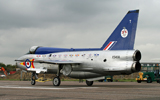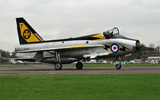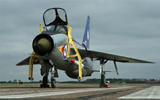English Electric Lightning

English Electric Lightning T.5 - XS458
The English Electric Lightning (later BAC Lightning) was a supersonic fighter aircraft of the Cold War era, particularly remembered for its great speed and natural metal exterior. It was the only all-British Mach 2 fighter aircraft. Greatly renowned for its capabilities as an interceptor, RAF pilots described it as "being saddled to a skyrocket". The Lightning was used throughout much of its service life by the Royal Air Force and the Royal Saudi Air Force. The aircraft was a stunning performer at airshows. It broke the world air-speed record and was the first aircraft capable of supercruise. The Lightning was also one of the highest performance planes ever used in formation aerobatics.
The Lightning prototype, known as P.1, was built to satisfy the British Air Ministry's 1947 specification F23/49 and flew for the first time from RAF Boscombe Down on 4th August 1954. This specification followed the cancellation of the Air Ministry's 1942 E.24/43 supersonic research aircraft specification which had resulted in the Miles M.52. The P1's designer was W.E.W. Petter, formerly chief designer at Westland Aircraft. The design was controversial and the Short SB.5 was built to test wing sweep and tailplane combinations. The original combination was proved correct. The forerunner of the Lightning series was the P.1A and P.IB flying "proof-of-concept" aircraft. Looking very much like the production series, the prototypes were distinguished by the rounded-triangular intakes, short fins and lack of radar or operational equipment. On 25th November 1958, the P.1B became the first British aircraft to fly at Mach 2. The Lightning was specifically designed as a point defence interceptor, essentially a guided missile-armed, air superiority fighter optimised to defend mainland Britain against bomber attacks.
In order to reduce cross sectional area of the fuselage and improve performance, the fuel capacity was highly restricted. A unique way of minimising the drag of the twin engine installation was put forward by Petter. This involved stacking the engines vertically, effectively tucking them behind the cockpit, fed from the nose and achieving minimum frontal area. This effectively gave twice the thrust of its contemporaries for an increase in frontal area of only 50%. The Ferranti AI23 AIRPASS: Airborne Interception Radar and Pilot Attack Sight System was mounted in the shock cone. Limitations of fuel capacity dominated this aircraft's design as its fuselage was nearly all engines and ducting, and thus could not hold much fuel. Hence all available room was adapted to the purpose of holding fuel. The flaps were even used as fuel tanks, and the landing gear had very narrow tyre's that retracted outward so that there could be greater tankage inboard. This also meant that when the addition of drop tanks for greater range was considered, they could not be placed beneath the wing and were mounted on top instead. When the aerodynamic principle of the area rule became standard practice, a ventral tank was added to the fuselage so the aircraft could carry more fuel while being more aerodynamic.



The first operational aircraft, a preproduction P.1B (XG336), arrived at RAF Coltishall in Norfolk in December 1959. From 1960 the production mark F.1 served initially with No.74 Squadron. An improved variant the F.2 first flew on 11th July 1961 and entered service with No.19 Squadron at the end of 1962. The F.3 was first flown on 16th June 1962 and the longer-range F.6 on 16th June 1965. The versions sold to Saudi Arabia were essentially similar to the T.5 and F.6 models in UK service and this final production batch reverted to the classic natural metal external finish which lasted well in the drier Arabian climate.
During the 1960s, as strategic awareness increased and a multitude of alternative fighter designs were developed by Warsaw Pact and NATO members, the Lightning's shortcomings in terms of range and firepower became increasingly apparent.
The withdrawal of McDonnell Douglas F-4 Phantoms from Royal Navy service enabled these slower but much longer-ranged aircraft to be added to the RAF's interceptor force alongside those withdrawn from Germany which were being replaced by SEPECAT Jaguars in the ground attack role. Later the Tornado F.3s also arrived to defend UK airspace. While slower and less agile than the Lightning, the Tornado carries a much larger armament load and much more advanced avionics. Lightning's were slowly phased out of service between 1974 and 1988, although much testing and modification was needed to keep them in air-worthy condition due to the high number of flight hours accumulated. The English Electric Lightning is credited with a single kill, ironically a British aircraft, a Harrier pilot ejected, but the pilot less aircraft continued to fly. The order was given to shoot down the aircraft and the Lightning achieved this successfully.
In their final years of UK service, all RAF Lightning's were based at RAF Binbrook in Lincolnshire and many were camouflaged to make them less conspicuous when flying at low level. They tended to defend the Flamborough Head Sector of airspace above the North Sea. These later aircraft were the single-seater F.3 and F.6 and the twin seat trainer variant T.5, all constructed by British Aircraft Corporation and distinguished from earlier versions by their flat topped fins. In their last year of service their pilots regularly pushed the aircraft to their limits as they used up the remaining hours of fatigue time.
Many Lightnings are conserved in museum collections where they delight visitors with their clean sleek lines, evocative of the high speeds that they once attained. The Civil Aviation Authority refused a licence for the surviving airworthy examples to perform at air shows in the UK but there are a few flying in South Africa.
| Model | Production |
|---|---|
| P.1A | 3 |
| P.1B | 3 |
| F.1 | 42 |
| F.1A | 29 |
| F.2/F.52 | 44 Built (6 of which converted to F.52) |
| F.2A | 31 (All F.2 conversions) |
| F.3 | 71 (10 F.1 conversions) |
| F.3A | 17 (1 F.3 conversion) |
| T.4/T.54 | 21 (2 of which converted to T.54) |
| T.5 | 24 (2 T.4 conversions) |
| F.6 | 63 (8 F.3 and 5 F.3A conversions) |
| F.53 | 47 ( 1 F.3 conversion) |
| T.55 | 9 (1 T.5 conversion) |
| Length: | 55.25ft (16.84m) |
| Width: | 34.84ft (10.62m) |
| Height: | 19.59ft (5.97m) |
| Accommodation: | 1 |
| Hardpoints: | 4 |
| Empty Weight: | 28,036lbs (12,717kg) |
| MTOW: | 41,991lbs (19,047kg) |
| Max Speed: | 1,312mph (2,112kmh; 1,140kts) |
| Max Range: | 802miles (1,290km) |
| Rate-of-Climb: | 50,000ft/min (15,240m/min) |
| Service Ceiling: | 55,020ft (16,770m; 10.4miles) |
| Engine: | 2 x Rolls-Royce Avon 301 engines generating 16,360lbs of thrust with afterburn |
| Armament Standard: | 2 x 30mm ADEN cannons in nose |
| Armament Optional: | de Havilland Firestreak infrared air-to-air missiles Hawker Siddeley Red Top infrared air-to-air missiles Matra rocket pods (18 x SNEB 68mm rockets) Matra JL-100 rocket pods (19 x SNEB 68mm rockets) Conventional Drop Bombs Conventional Drop Tanks "Overwing" Fuel Tanks Vinteen 360 70mm cameras Up to 6,000lbs of external ordnance |
